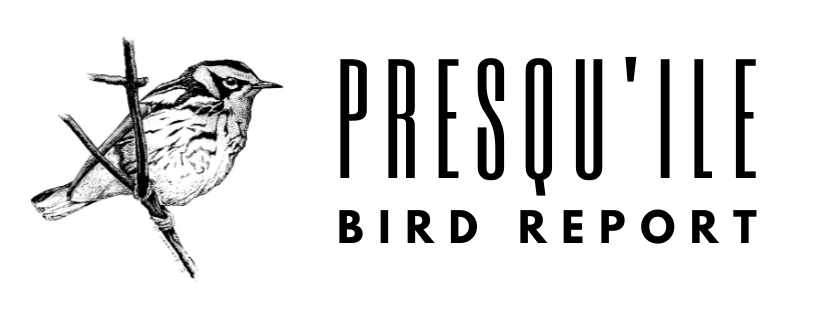
Winter birding has set in at Presqu'ile Provincial Park, though winter weather certainly has not. Such conditions favour the search for unusual species that occasionally visit the great lakes at this time of year.
A dozen or so TUNDRA SWANS were in Popham Bay on November 22 and a flock of that size flew over Presqu'ile Bay on the following day. The AMERICAN WIGEONS in the marsh have not been seen since November 23, but the two NORTHERN PINTAILS are still there. On November 23, the ducks in the marsh were joined by a RING-NECKED DUCK. WHITE-WINGED SCOTERS can usually be seen with a scope from Gull Island, and a BLACK SCOTER was spotted there on November 22. Two COMMON LOONS off the calf pasture and four HORNED GREBES off Gull Island may be the last of those species until next spring. The same may be true of DOUBLE-CRESTED CORMORANTS, singles of which were in Presqu'ile Bay on November 23 and on Gull Island on November 26. GREAT BLUE HERONS were seen on three different days this week: one in the marsh on the 22nd, two flying around the calf pasture on the 23rd, and one flying towards the lighthouse on the 26th.
Once inland waters begin to freeze over and ducks gather in Presqu'ile Bay, there will be a greater probability of seeing BALD EAGLES there.
Until then, the raptor count seems restricted: single NORTHERN HARRIERS on Gull Island; a NORTHERN GOSHAWK near the lighthouse; and at least two different RED-TAILED HAWKS that are being seen almost every day. BARRED OWLS continue to be seen from time to time, one observer having found six on November 22. A RUFFED GROUSE was stalking the feeder at 85 Bayshore Road, and a WILD TURKEY was on the road at 111 Bayshore.
Shorebirds made a bit of a comeback this week, with the same five species seen on Gull Island/Sebastopol Island on November 22 and 26:
KILLDEER (presumably the same bird that has been present since November 11); SANDERLING (two on Sunday and one still present today); single WHITE-RUMPED SANDPIPER (seen every non-hunting day this week); PURPLE SANDPIPER (one on Gull Island on Sunday and on Sebastopol Island today); DUNLIN (seven on Sunday and two today). An adult LITTLE GULL was discovered among the BONAPARTE'S GULLS on beach 1 on November 20, and two were off Gull Island on November 22. Birders wanting to be tempted by the prospect of an extreme rarity in the form of an /alcid/ should be aware that this is the week when dozens of THICK-BILLED MURRES descended on Lake Ontario 59 years ago, and, more recently, the week when a RAZORBILL appeared at the mouth of the Niagara River. I gannet swallow ani murre of those fantasies!
A BELTED KINGFISHER was still at the calf pasture on November 23. A NORTHERN SHRIKE was there on November 21. Two AMERICAN PIPITS on Gull Island and one over Owen Point were rather late. SNOW BUNTINGS move constantly up and down the beach. The ROSE-BREASTED GROSBEAK mentioned in last week's report continues to appear irregularly (often around mid-day), most recently on November 24. As long as the weather remains mild and food remains in the feeder (which was mysteriously re-filled recently), the bird is likely to stay in the area.
To reach Presqu'ile Provincial Park, follow the signs from Brighton.
Locations within the Park are shown on a map at the back of a tabloid that is available at the Park gate. Visitors to Gull Island not using a boat should be prepared to wade through ankle-deep water that sometimes has waves that reach the shins. With hip waders one can walk to Sebastopol Island from Gull Island, but wading to High Bluff Island is not possible. It should also be noted that, because duck hunting is given priority on Mondays, Wednesdays, Fridays, and Saturdays, Gull Island, High Bluff Island, Owen Point, and part of the calf pasture are not available for bird-watching on those days until December 20. Birders are encouraged to record their observations on the bird sightings board provided near the campground office by The Friends of Presqu'ile Park and to fill out a rare bird report for species not listed there.
Fred Helleiner


